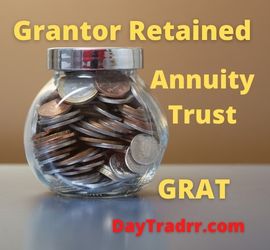What Is a Grantor Retained Annuity Trust (GRAT)?
 A grantor retained annuity trust (GRAT) is a financial tool used in estate planning to reduce taxes on substantial financial transfers made to family members. In these arrangements, an irrevocable trust is established for a specific length or period of time. When the trust is formed, the individual who creates it determines a gift value. The trust is funded with assets, and an annuity is provided to the donor each year. When the trust ends, the final annuity payment is made. At this point, the beneficiary receives the remaining assets while paying little or no gift taxes.
A grantor retained annuity trust (GRAT) is a financial tool used in estate planning to reduce taxes on substantial financial transfers made to family members. In these arrangements, an irrevocable trust is established for a specific length or period of time. When the trust is formed, the individual who creates it determines a gift value. The trust is funded with assets, and an annuity is provided to the donor each year. When the trust ends, the final annuity payment is made. At this point, the beneficiary receives the remaining assets while paying little or no gift taxes.
A Grantor retained annuity trust (GRAT) allows a trustmaker to pass on increasing assets to the next generation. He can do this with little to no gift or estate tax repercussions. GRATs allow wealthy families to freeze the value of their estate. Thus transferring any future appreciation to the following generation tax-free. Furthermore, GRATs have few drawbacks and little downside. A GRAT is formed when a grantor gives assets with the potential for appreciation to a fixed-term, irrevocable trust. The grantor then maintains the right to receive an annuity stream for the duration of the trust. The assets are dispersed to noncharitable beneficiaries at the conclusion of the period. Often, these are the grantor’s children.
GRAT – A Closer Look at Grantor Retained Annuity Trusts
A grantor retained annuity trust is a form of an irrevocable gifting trust. It allows a grantor or trustmaker to potentially convey large wealth to the next generation. Further, the grantor does this while incurring little or no gift tax. A GRAT is put in place for a set number of years. The grantor provides assets in trust but retains the right to receive the original value of the assets. The grantor receives this payback during the life of the GRAT in the form of an annuity. It is paid at an IRS-specified rate of return known as the 7520 rate. When the period of the GRAT expires, the remaining assets are distributed to the grantor’s beneficiaries. Ultimately, the remainder is any appreciation of the initial assets less the IRS-assumed return rate.
The GRAT is funded at the fair market value of the assets used to fund the GRAT. The term is the time during which property is still held in trust. The grantor is the only beneficiary of the trust during the GRAT period. Therefore, the annuity payments are the only distributions made from the GRAT. After the term of the GRAT expires, the final annuity payment is paid. Any property remaining in the GRAT may be retained in a continuing trust for the benefit of family members. Alternatively, it can be distributed outright to them.
Grantor Retained Annuity Trust Uses
A GRAT is especially beneficial to an affluent person subject to a high estate tax burden upon his death. In this situation, a GRAT can be used to freeze the value of his estate. He can do this by moving some or all of the appreciation to their heirs. For example, if a person has a $10 million asset that is predicted to increase to $12 million in the following two years, they can pass the difference to their children tax-free. GRATs are notably popular among individuals who own stock in start-up firms. Particularly when the stock price increase for IPO shares outpaces the IRS expected rate of return. This implies that more money can be passed down to children or other heirs. Further, it can be structured without depleting the grantor’s lifetime exemption from estate and gift taxes.
Grantor Retained Annuity Trust History
GRATs gained a significant increase in popularity in 2000. This was due to a favorable judgment in the United States Tax Court involving the Walton family of Walmart Inc. The court ruled in favor of Walton’s use of two GRATs. Annuity payments were set up to return all original assets to the grantor and leave only the appreciated value to beneficiaries. The value of the initial gift placed in trust is reduced to zero. Any leftover value in the trust is handed to the beneficiary tax-free. GRATs used in this manner are referred to as zeroed-out GRATs or Walton GRATs. (Source: Audrey J. Walton v. Commissioner of Internal Revenue)
GRAT Provisions to Keep in Mind
If the grantor dies before the end of the GRAT period, all trust assets are restored to the grantor’s estate. As a result, they are reported as estate tax assets. To lessen the chance of mortality, grantors frequently choose durations of two to three years for the GRAT. Alternatively, grantors can use a rolling GRAT plan. With rolling short-term GRATs, annuity payments from one GRAT finance a new GRAT. Therefore, if the grantor dies, only the assets in the active GRAT return to their estate.
It’s also critical for grantors to be up to date on GRAT laws. Employing GRATs can assist eliminate or decrease estate and gift tax liabilities. As a result, there have been recommendations to tighten limits. For example, mandating a 10-year minimum fixed duration or abolishing the zeroed-out GRAT method.
Zeroed-out GRAT
GRATs are often constructed so that the present value of the annuity stream during the GRAT period as of the date of financing equals the entire value of the property utilized to fund the GRAT. This is known as a “zeroed-out GRAT.” Its name is self-explanatory as the value of the leftover interest, meaning the amount left over after the GRAT period is zero. It is not accidental because the grantor structures an annuity equal to what he or she pays to the GRAT. At the end of the GRAT term, the beneficiaries receive only the appreciation value of the initial assets. Further, it is seen as a zero-value gift in the eyes of the IRS. Therefore, it does not use any of the grantor’s lifetime exemption from federal gift tax. In this manner, assets left in the GRAT after the last annuity payment are gift-tax-free to the residual beneficiaries.
GRAT – Example of a Grantor Retained Annuity Trust
A dramatic example of wealth transfer through a GRAT involves Mark Zuckerberg and Dustin Moskovitz, the co-founders of Facebook. They utilized the estate planning instrument in 2008 when they were both 24 years old. It entailed putting pre-IPO stock into Grantor Retained Annuity Trusts, which skyrocketed in value once the business went public. By the end of the procedure, Zuckerberg and Moskovitz transferred $185 million to trust beneficiaries without having to pay the gift tax. This is according to FORBES’ conservative estimate. Sheryl Sandberg, the then-39-year-old CEO of Facebook, used the identical approach to transfer at least $19 million tax-free.
Perhaps the most dramatic example involves Mark Zuckerberg and Dustin Moskovitz, the co-founders of Facebook and two of the world’s youngest billionaires. In 2008, when they were both 24, they used an estate planning tool that’s more familiar to people two or three times their age. It involved putting pre-IPO stock into a special kind of trust that will explode in value when the company goes public. In the process, Zuckerberg and Moskovitz, by FORBES’ conservative estimate, will together shift $185 million to trust beneficiaries without having to pay gift tax. Sheryl Sandberg, Facebook’s CEO, who was then 39, used the same strategy to transfer at least $19 million tax-free. (Source: forbes.com)
Up Next: What Is a Management Buyout (MBO)?
 A management buyout (MBO) is a transaction in which the management team of a company buys the assets and operations from the previous owners. Sometimes, managers pool their resources. However, the buyout is frequently financed using a combination of equity and debt financing. Managers who aspire to be business owners rather than workers are typically drawn to the notion of an MBO. MBOs are a common tool for small business handovers. However, they are also useful for taking public firms private in order to remodel operations, simplify operations, and boost profitability. They can also be used to split divisions of major corporations into distinct enterprises.
A management buyout (MBO) is a transaction in which the management team of a company buys the assets and operations from the previous owners. Sometimes, managers pool their resources. However, the buyout is frequently financed using a combination of equity and debt financing. Managers who aspire to be business owners rather than workers are typically drawn to the notion of an MBO. MBOs are a common tool for small business handovers. However, they are also useful for taking public firms private in order to remodel operations, simplify operations, and boost profitability. They can also be used to split divisions of major corporations into distinct enterprises.
The management team normally combines personal resources to provide funds for the MBO while obtaining debt financing. The loan is typically done through a business development firm or another external lender. Seller financing is often a component and frequently included as part of the MBO deal. The team’s personal investment demonstrates their motivation and individual commitment to expand and grow the company.




